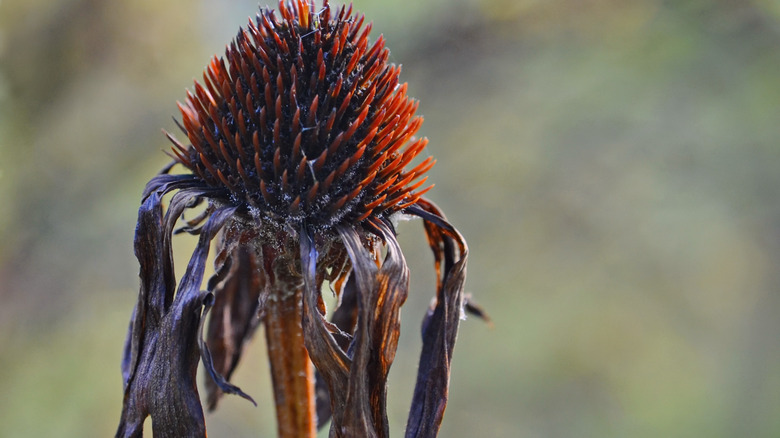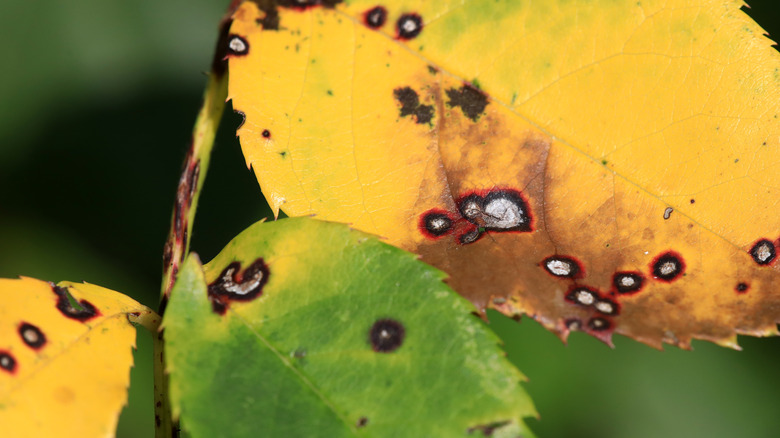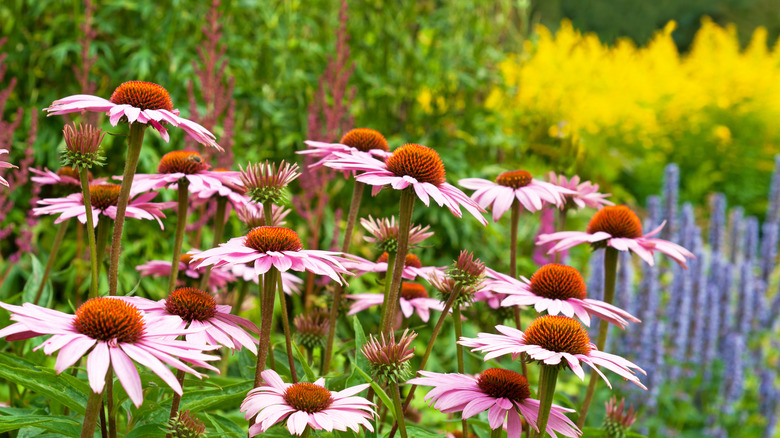Save Your Coneflowers From A Premature Death By Looking Out For This
We may receive a commission on purchases made from links.
Echinacea, commonly known as coneflowers, attracts butterflies, bees, and birds due to its food source of nectar and seeds. These perennial flowers are a part of the daisy family, resembling the white and yellow flower most of us are familiar with. The purple coneflower is the most common echinacea and adapts to just about any environment. However, coneflowers, like other garden plants, are susceptible to leaf spot. This bacterial disease is caused by Pseudomonas or Xanthomonas bacteria and progresses throughout the summer. It's typically noted by its dark brown and black spots surrounded by a halo of yellow that appears on leaves, directly impacting photosynthesis and weakening the plant. As it progresses, it can cause leaves and flowers to die and fall off the plant. In some cases, it can prematurely kill the entire plant.
Leaf spot disease thrives in high humidity and long periods of wetness. Prolonged rain and overhead watering can cause this disease to increase rapidly, especially if plants aren't in full sun. Recognizing the signs and knowing how to treat them can help save your garden and purple coneflowers from premature death.
How do you treat leaf spots on coneflowers?
There are a few ways you can prevent leaf spot. One of the easiest ways is to water in the morning at the soil line instead of overhead watering. Overhead watering can spread disease by allowing bacteria to move freely, causing plant damage. Another way is to avoid planting your coneflowers too close together. This overcrowding limits air circulation, contributing to prolonged, wet leaves.
Treating and controlling leaf spot requires a few different methods. Copper fungicide combined with a plant-resistant inducer is a great way to help protect your plants. Copper sprays impair the pathogens' molecules before they can affect the plant. Captain Jack's Liquid Copper Fungicide Spray is available at Walmart for around $6. This spray is perfect for organic gardening and helps control a few other plant diseases, including powdery mildew, downy mildew, rust, late blight, and more. A plant-resistant inducer encourages the plant to activate its natural defense mechanisms. Regalia Biofungicide is available at Arbico Organics for $51. A quart of this product lasts three years and also treats a variety of fungal and bacterial diseases. It is hazardous to humans and domestic animals, so read the instructions before applying. You can also cut off affected parts of the plant. But make sure to clean and disinfect your gardening tools with alcohol in between cutting to avoid spreading diseases to other plants.
Can you save coneflowers with leaf spot?
While coneflowers with leaf spot can be saved, the prognosis depends on a few factors. These include the severity of the disease and the plant's overall health. If the disease gets out of control and systemically infects the entire plant, it can be more challenging to manage. The best intervention is prevention. If you notice your plants are newly infected with leaf spot, you can remove the infected parts of the plants and apply copper and plant-resistant inducers. However, if it's more advanced, you'll want to remove and destroy the plant before it spreads further. More severe stages of the disease tend to weaken the plant and make it susceptible to pests and other diseases.
Keep a close eye on your coneflowers for any signs of leaf spot or other disease. Early detection can help increase the chances of a full recovery and prevent it from spreading to other plants in your garden. Make sure you choose unaffected seeds and plants, plant in a full-sun location with well-draining soil, and make sure there's lots of space between plants to encourage airflow.


